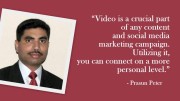There’s a lot that goes into making a journalist care for your press release or close it as soon as it’s opened. And the harsh truth is that most press releases don’t get published in desired, or many a times in no publications. The reasons could be various. But they spring out of some core factors. Here’s how to make a press release impactful.
- Subject line: Make the first impression right – In the digital age, the subject line is as important as the headline. In fact, it’s even more important in the sense that it helps define your email’s open rate by the media fraternity. One can easily judge the effectiveness of your press release from your email’s subject line. Here’s your chance to pull in journalists seeking good stories. Hence, make it formal, yet newsworthy and attention-grabbing. Write what you must for a journalist to care to open the email.
- Headline: Make your headline read like it should in the newspaper – Once the journalist manages to open the press release, the headline is the second and most important defining line. A well-written headline is what catches the reader’s attention. And when writing the headline, length matters. Write tweetable and socially sharable headlines. It should neither be too long nor too short. Make sure you mention your most important keywords in the headline. A good headline best captures the essence and the newsworthiness of the press release.
- Don’t get lost in words – It’s important to stick to the point where you should and elaborate on points that need explanation. However, while writing a press release and bragging about the brand and its achievements, don’t get so lost that you lose the entire context and lose the reader’s attention half way through the press release. Hence, keep every following statement and paragraph, well knit and seamless. The writing and information shared should engage and not confuse the journalist. Also, use subheads to break the monotony and keep the reader’s interest.
- Share news only if there is one – It helps to understand what piece of information is good for internal communication and what should make way into a media release. Because not every company update is newsworthy. And if a journalist is bombarded with releases every other day, the actually important ones end up in the journalist’s email trash can. So, understand what news is worth sharing with journalists. And it’s equally important to know how many releases should one circulate in a month or quarter so as to maintain media interest in the brand.
- End it well – Like the right beginning, it’s important to conclude the press release well. An abruptly ending press release has little chances of making headlines in the publication the next day. Write a concise ending to tie things off. Tipping off the journalist on what the brand’s next big plans are, could also have him glued on to the brand, and hence the release. Conclude your press release with appropriate contact information of who maybe contacted for further queries and coordination.
- Know your target media – Float the press release in the right sections of media – Determine your press release’s level of worthiness for different kinds of media and accordingly float it. Not every press release can make it to the mainstream category A media. Hence, it helps to know the genre (beat) and media category wherein the news has to be floated. It should also be helpful to slightly change the press release to suit different press groups.
In short, write an interesting, captivating and newsworthy press release and circulate it in the right group of journalists to have the news item picked and published in your desired media house.










nice brief focused to the point suggested in making press release